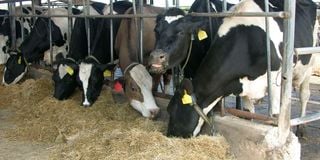Why crossbreed of Friesian and Sahiwal is a gem for small dairy farms

Friesian cows at Chemusian Farm.
A forage-based dairy feeding and breeding system promises to turn around the struggling smallholder dairy sector.
With the bulk of milk production in the country being the domain of smallholder farmers with one to two acres, the initiative by Kenya Agricultural and Livestock Research Organisation (Kalro) (Naivasha), Self Help Africa and Irish Embassy, aims to develop dairy cattle breeding programmes that are appropriate for the feed resources available in different ecological zones.
“A good forage-based system should meet more than 90 per cent of the animal’s dietary requirements and help cut costs on concentrates, such dairy meal, that the farmer buys from the shops. We target a production of at least 15 litres per cow per day,” says Richard Onyango, the project manager.
Dr Seamus Grosse, a dairy expert from Ireland, says the research at Kalro focuses on three key elements, the first being to establish which breed of cattle is best to use in the environments.
“This means we have to develop a dairy cattle breeding index. Second is to come up with an appropriate feeding system. Currently, we are looking at different crops such as lucerne, napier grass and sweet potatoes. Third is taking the information to farmers, extension officers and cooperative societies.”
Dr Crosse is concerned that dairy farmers in Kenya prefer imported sires, which although they have traits for more milk, feed heavily in the process. Vouching for feeding with forages, he says milk output in Ireland has almost doubled in the last 15 years because farmers have relied more on grass to feed their animals and the breeds are specific to grass-based systems.
Paul Leparmarai, a forage-based dairy researcher at Kalro says under the feeding regime, “Friesians recorded the highest milk production followed by the Friesians crossed with Sahiwals. Sahiwal and Jersey breeds gave the lowest milk production per day”.
But Leparmarai adds that the findings will need to be subjected to further tests especially on variables such as fodder growing conditions – irrigation vs rain-fed – and ecological conditions. Overall, the production outcome of the compromise of high-producing Friesian and the hardy Sahiwal seemed a viable option many small-scale farmers may wish to take as a mitigating measure to the adverse effects of climate change on the dairy industry.
Another vital lesson is on forage conservation (silage, haylage and hay). Having adequate feed during dry periods improves the performance of animals. The manager at Development Pamoja, Mr. James Hennessy, observes that “farmers harvest lots of hay during the rainy season and sell at throwaway prices.
Then later during the dry season, they buy the same hay later at high prices. To discourage our members from this loss-making behaviour, we store the hay for them. The farmer also uses the hay he delivers as a collateral for loans from the institution”.
The team of scientists from Kalro and Self Help Africa agree that in higher altitudes, the inter-cropping of napier and desmodium grasses produce a higher dry matter yield (DMY) per cut while sorghum produces the highest DMY in lower, drier areas.
William Ayako, another expert, said that “sweet potato vines produced more dry matter and protein per cut than lucerne but more DMY is realised with the latter in the end because of the many cuts possible’’.





